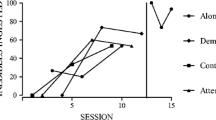Abstract
The effect of a long-term intensive treatment program on the occurrence of pica in a woman with profound mental retardation and epilepsy was investigated. The study utilized four treatment strategies: (1) edible/inedible discrimination training with hand held restraint; (2) edible/inedible discrimination training with facial screening, hand held restraint and a baiting procedure; (3) disposal training with facial screening, hand held restraint, and a baiting procedure; and (4) disposal training with hand held restraint and a baiting procedure. The strategies were implemented in phases to: (a) eliminate life-threatening pica; (b) determine the impact of facial screening on pica, and (c) determine which components were effective at eliminating pica. Pica was successfully reduced after 5 years of intensive program implementation. Facial screening played a substantial role in the reduction of pica. The most effective treatment package: (a) taught the client to dispose of inedibles, (b) used baiting sessions, and (c) consequated pica with 15 sec of hand held restraint. At follow-up, the client's pica behavior was responsive to staff monitoring and verbal reprimands. Interpretation of the results were limited given the research design employed.
Similar content being viewed by others
References
Albin, J. (1977). The treatment of pica (scavenging) behavior in the retarded: a critical analysis and implications for research.Mental Retard. 15: 14–17.
American Psychiatric Association (1987).Diagnostic and Statistical Manual of Mental Disorders, Third Edition, Revised, American Psychiatric Association, Washington, D.C.
Ausman, J., Ball, T. S., and Alexander, D. (1974). Behavior therapy of pica with a profoundly retarded adolescent.Mental Retard. 12: 16–18.
Bicknell, J. (1975).Pica: a Childhood Symptom, Camelot Press, Southhampton, England.
Bucher, B., Reykdal, B., and Albin, J. (1976). Brief physical restraint to contract pica in retarded children.J. Behav. Ther. Exp. Psychiatry 7: 137–140.
Crosby, W. H. (1971). Food pica and iron deficiency.Arch. Int. Med. 127: 960–961.
Danford, D. E., and Huber, A. M. (1982). Pica among mentally retarded adults.Am. J. of Ment. Def. 87: 141–146.
Favell, J. E., McGimsey, J., and Schell, R. (1982). Treatment of self-injury by providing alternate sensory activities.Anal. Intervent. Dev. Dis. 2: 83–104.
Foxx, R. M. and Azrin, N. H. (1973). The elimination of autistic self-stimulatory behavior by overcorrection.J. Appl. Behav. Anal. 6: 1–14.
Foxx, R. M., and Martin, E. D. (1975). Treatment of scavenging behavior (coprophagy and pica) by overcorrection.Behav. Res. Ther. 13: 153–162.
Horton, S. V. (1987). Reduction of disruptive mealtime behavior by facial screening.Behav. Mod. 11: 53–64.
Kanner, L. (1962).Child Psychiatry, Charles C Thomas, Springfield, IL.
Kazdin, A. E. (1988),Child Psychotherapy. Developing and Identifying Effective Treatments, Pergamon Press, New York.
Lofts, R. H., Schroeder, S. R., and Maler, R. H. (1990). Effects of serum zinc supplementation on pica behavior of persons with mental retardation.Am. J. Ment. Retard. 95: 103–109.
Lutzker, J. R. (1978). Reducing self-injurious behavior by facial screening.Am. J. Ment. Def. 82: 510–513.
Mabry, J. H., Richmond, G., Wells, M. E., Bell, J. J. C., and Springer, B. M. (1982).The Incidence of Pica at a Large State-Operated Mental Retardation Center, 8th Annual Convention of the Association for Behavior Analysis, Milwaukee WS.
Mace, F. C., and Knight, D. (1986). Functional analysis and treatment of severe pica.J. Appl. Behav. Anal. 19: 411–416.
McAlpine, C. and Singh, N. N. (1986). Pica in institutionalized mentally retarded persons.J. Ment. Def. Res. 30: 171–176.
McGonigle, J. J., Duncan, D., Cordisco, L., and Barrett, R. P. (1982). Visual screening: An alternative method for reducing stereotypic behaviors.J. Appl. Behavior Anal. 15: 461–467.
Moncrieff, A. A., Koumides, O. P., Clayton, B. E., Patrick, A. D., Renwick, A. G., and Roberts, G. E. (1964). Lead poisoning in children.Arch. Dis. Child. 39: 1–13.
Mulick, J. A., Barbour, R., Schroeder, S. R., and Rojahn, J. (1980). Overcorrection of pica in two profoundly retarded adults: Analysis of setting effects, stimulus, and response generalization.Appl. Res. Ment. Retard. 1: 241–252.
Paisey, T. J. H., and Whitney, R. B. (1989). A long-term case study of analysis, response suppression, and treatment maintenance involving life threatening pica.Behav. Res. Treat. 4: 191–211.
Palmer, S., and Ekvall, S. (Eds.) (1978).Pediatric Nutrition in Developmental Disorders, Charles C Thomas, Springfield, IL.
Paniagua, F. A., Braverman, C., and Capriotti, R. M. (1986). Use of a treatment package in the management of a profoundly mentally retarded girl's pica and self-stimulation.Am. J. Ment. Def. 90: 550–557.
Rusch, F., Close, D., Hops, H., and Agosta, J. (1976). Overcorrection: Generalization and maintenance.J. Appl. Behav. Anal. 9: 498.
Singh, N. N., and Bakker, L. W. (1984). Suppression of pica by overcorrection and physical restraint: A comparative analysis.J. Aut. Devel. Dis. 44: 331–341.
Singh, N. N., Watson, J. E., and Winton, A. S. W. (1986). Treating self-injury: Water mist spray versus facial screening or forced arm exercise.J. Appl. Behav. Analy. 19: 403–410.
Singh, N. N., and Winton, A. (1984). Effects of a screening procedure on pica and collateral behaviors.J. Behav. Ther. Exp. Psychiatry 15: 59–65.
Singh, N. N., Winton, A., and Dawson, M. J. (1982). Suppression of antisocial behavior by facial screening using multiple baseline and alternating treatments designs.Behav. Ther. 13: 511–520.
Watson, J., Singh, N. N., and Winton, A. S. W. (1986). Suppressive effects of visual and facial screening on self-injurious finger-sucking.Am. J. Ment. Def. 90: 526–534.
Winton, A. S. W., and Singh, N. N. (1983). Suppression of pica using brief-duration physical restraint.J. Ment. Def. Res. 27: 93–103.
Winton, A. S. W., Singh, N. N., and Dawson, M. J. (1984). Effects of facial screening and blindfold on self-injurious behavior.Appl. Res. Ment. Retard. 5: 29–42.
Wylie, A. M., Welkowitz, L. A., and Cassisi, J. E. (1982).Multiple Response Assessment and the Effects of Overcorrection on Pica Behavior. 8th Annual Convention of the Association for Behavior Analysis, Milwaukee, WS.
Author information
Authors and Affiliations
Rights and permissions
About this article
Cite this article
Bogart, L.C., Piersel, W.C. & Gross, E.J. The long-term treatment of life-threatening pica: A case study of a woman with profound mental retardation living in an applied setting. J Dev Phys Disabil 7, 39–50 (1995). https://doi.org/10.1007/BF02578713
Issue Date:
DOI: https://doi.org/10.1007/BF02578713



